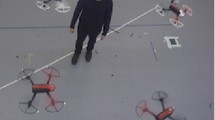Abstract
In this work we consider the problem of controlling a team of micro-aerial vehicles moving quickly through a three-dimensional environment while maintaining a tight formation. The formation is specified by shape vectors which prescribe the relative separations and bearings between the robots. To maintain the desired shape, each robot plans its trajectory independently based on its local information of other robot plans and estimates of states of other robots in the team. We explore the interaction between nonlinear decentralized controllers, the fourth-order dynamics of the individual robots, time delays in the network, and the effects of communication failures on system performance. Simulations as well as an experimental evaluation of our approach on a team of quadrotors suggests that suitable performance is maintained as the formation motions become increasingly aggressive and as communication degrades.











Similar content being viewed by others
References
Beard, R. W., Lawton, J., & Hadaegh, F. Y. (2001). A coordination architecture for spacecraft formation control. IEEE Transactions on Control Systems Technology, 9(6), 777–790.
Desai, J. P., Ostrowski, J. P., & Kumar, V. (2001). Modeling and control of formations of nonholonomic mobile robots. IEEE Transactions on Robotics, 17(6), 905–908.
Egerstedt, M., & Hu, X. (2001). Formation constrained multi-agent control. IEEE Transactions on Robotics and Automation, 17(6), 947–951.
Fax, J. A., & Murray, R. M. (2004). Information flow and cooperative control of vehicle formations. IEEE Transactions on Automatic Control, 49(9), 1465–1476.
Franchi, A., Giordano, P., Secchi, C., Son, H., & Bülthoff, H. (2011). A passivity-based decentralized approach for the bilateral teleoperation of a group of uavs with switching topology. In Proc. IEEE intl conf. on robotics & automation.
Gu, Y., Seanor, B., Campa, G., Napolitano, M. R., Rowe, L., Gururajan, S., & Wan, S. (2006). Design and flight testing evaluation of formation control laws. IEEE Transactions on Control Systems Technology, 14(6), 1105–1112.
Jadbabaie, A., Lin, J., & Morse, A. S. (2003). Coordination of groups of mobile autonomous agents using nearest neighbor rules. IEEE Transactions on Automatic Control, 48(6), 988–1001.
Jadbabaie, A., Yu, J., & Hauser, J. (2001). Unconstrained receding-horizon control of nonlinear systems. IEEE Transactions on Automatic Control, 46(5), 776–783.
Keviczky, T., & Johansson, K. (2008). A study on distributed model predictive consensus. arXiv:0802.4450.
Latouche, G., & Ramaswami, V. (1999). Introduction to matrix analytic methods in stochastic modeling. Philadelphia: ASA-SIAM.
Lee, T. (2011). Geometric tracking control of the attitude dynamics of a rigid body on SO(3). In Proc. of the Amer. control conf., San Francisco, CA.
Lee, T., Leok, M., & McClamroch, N. H. (2010). Geometric tracking control of a quadrotor UAV on SE(3). In Proc. of the IEEE conf. on decision and control, Atlanta, GA.
Mellinger, D., & Kumar, V. (2011). Minimum snap trajectory generation and control for quadrotors. In Proc. of the IEEE intl. conf. on robot. and autom., Shanghai, China.
Mellinger, D., Michael, N., & Kumar, V. (2010). Trajectory generation and control for precise aggressive maneuvers with quadrotors. In Proc. of the intl. sym. on exp. robot., Delhi, India.
Mesbahi, M. (2005). On state-dependent dynamic graphs and their controllability properties. IEEE Transactions on Automatic Control, 50(3), 387–392.
Michael, N., Mellinger, D., Lindsey, Q., & Kumar, V. (2010). The GRASP multiple micro UAV testbed. IEEE Robotics & Automation Magazine, 17(3), 56–65.
Nieuwstadt, M. J. V., & Murray, R. M. (1998). Real-time trajectory generation for differentially flat systems. International Journal of Robust and Nonlinear Control, 8(11), 995–1020.
Ogren, P., Fiorelli, E., & Leonard, N. (2002). Formations with a mission: stable coordination of vehicle group maneuvers. In Proc. of intl. sym. on mathematical theory networks and syst., Notre Dame, IN.
Olfati-Saber, R., & Murray, R. M. (2002). Distributed cooperative control of multiple vehicle formations using structural potential functions. In Proc. of the IFAC world congress, Barcelona, Spain.
Olfati-Saber, R., & Murray, R. M. (2004). Consensus problems in networks of agents with switching topology and time-delays. IEEE Transactions on Automatic Control, 49(9), 1520–1533.
Shim, D., Kim, H., & Sastry, S. (2003). Decentralized nonlinear model predictive control of multiple flying robots. In Decision and control, 2003. Proceedings. 42nd IEEE conference on (Vol. 4, pp. 3621–3626). New York: IEEE.
Tabuada, P., Pappas, G. J., & Lima, P. (2001). Feasible formations of multi-agent systems. In Proc. of the Amer. control conf., Arlington, VA (pp. 56–61).
Tanner, H., Pappas, G. J., & Kumar, V. (2002). Input-to-state stability on formation graphs. In Proc. of the IEEE intl. conf. on robot. and autom., Las Vegas, NV (pp. 2439–2444).
Turpin, M., Michael, N., & Kumar, V. (2011). Trajectory design and control for aggressive formation flight with quadrotors. In Proc. of the intl. sym. of robotics research, Flagstaff, AZ.
Vicsek, T., Czirók, A., Ben-Jacob, E., Cohen, I., & Shochet, O. (1995). Novel type of phase transition in a system of self-driven particles. Physical Review Letters, 75(6), 1226–1229.
Author information
Authors and Affiliations
Corresponding author
Appendix: Multimedia supplement
Appendix: Multimedia supplement
The multimedia extension to this article is available at http://mrsl.grasp.upenn.edu/mturpin/AURO2011.mov.
Rights and permissions
About this article
Cite this article
Turpin, M., Michael, N. & Kumar, V. Trajectory design and control for aggressive formation flight with quadrotors. Auton Robot 33, 143–156 (2012). https://doi.org/10.1007/s10514-012-9279-y
Received:
Accepted:
Published:
Issue Date:
DOI: https://doi.org/10.1007/s10514-012-9279-y




